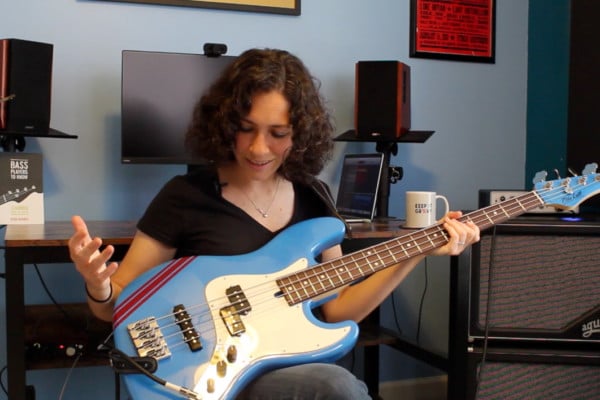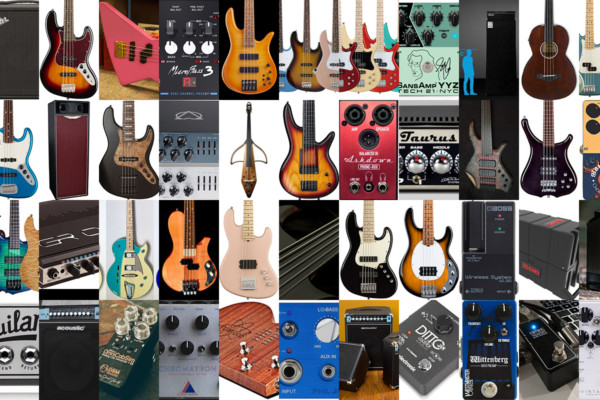Cabinet Size: Is Bigger Better?
Q: I have a question regarding the cabinet sizes. I see a lot of players lugging around some real beasts. I tend to use my DI for most medium to larger gigs and sometimes just go through the PA. I can’t see a need for a monster rig and wonder why so many bassist are breaking their backs lugging around 810 monster cabs. What’s your take?
A: You’ve hit on an interesting point! I know that when I first started gigging, I wanted the biggest sound I could find, and I was that guy lugging around an 810 cab.
Not for long though.
I soon realized that you can get an enormous sound out of a well built 410 cab or, my current preference, 2-112 cabs, stacked.
It’s true, most larger venues will have a decent PA and monitors. In a large hall, you really only want as much stage volume as you need for your own monitoring of your sound. However, keep in mind that there are often not enough monitor mixes to go around. and the bass player seems the first to get the shaft when there aren’t enough mixes. I often find that I can’t even get a monitor wedge, let alone my own mix, if the band is too large. So, you want to be able to cover your volume needs on the stage and let the house guy cover the house sound.
These days, there are also a lot of builders building really great sounding and light weight rigs. Most guys I know that still use big rigs use them for show or for sound. Tube amps are still preferred by many, and they will always be heavy. Rock and metal bands feel rockier with a nice fat rig on stage.
Personally, I’m a huge fan of the light weight revolution. That said, if I have roadies on a tour? I’ll probably opt for a nice tube amp simply for the overhead (power) and warmth. I must say that it is nice when you can really feel the bass behind you on stage. But lately, I’ve been using light weight gear.
Certainly as I get a little older, my back appreciates the relief and I’ve found experimented enough to find solutions that are easier to manage and still deliver the sound I’m after. I usually encourage my students to get a nice small to medium sized rig which can cover most local live scenarios, because it’ll be easier on them for 90% of their gigs and they can always get a little help from the PA and a monitor wedge any louder venues.
Ultimately, my advice is to consider your gigging needs. If you exclusively play in a death metal band, you probably want at least a 410 and a 500 watt or higher power amp. If you’re playing a lot of casuals, restaurants and the occasional loud bar, consider something in between raging amp and practice amp… something you can lift but something that you can also hear.
I play in most every sized venue there is, so I’ve got an assortment. I have two different power amps, 3 different 112 cabs that I can use standalone or chained together and a 410 cab. I like to have the right rig for the gig, but I also do it for a living and can often gig with up to three or four different bands in any given week.
Have a question for Damian Erskine? Send it to [email protected]. Check out Damian’s instructional books, Right Hand Drive and The Improviser’s Path.




I think it depends on the overall volume of the band. If you play with a monster drummer or a pair of guitar players who really like the “11” settings on their amps, you need a larger rig to move enough air that you can hear and feel yourself on stage.
I’ve found that positioning of the cab makes a difference too. A 4×10 on the floor is not as discernible to you the bassist as one that’s a couple of feet up in the air. The trade off may be some loss of very low-end feel. I have a friend who lugs his 1×15 around just to use as a stand for his 4×10. (He never plugs in the 15.) That gives him a nice balance between direct-to-the-ear sound and a decent amount of feel.
Obviously the discussion around how much rig you need could go on forever because every situation is different, but for me the bottom line is that I require just enough air moving around me so I can hear my notes and get at least some sense of the “rumble” as well. Else why be a bassist? :)
Thanks Damian! Good thoughts.
I’m also digging running my own mini-mix and using in-ears. Gives me better control over the stage volume my ears have to experience.
The big loss there is the *look* so one band I play in has taken to bringing an empty set of cabs to put behind me. Seriously. :)
–p
I gig with a SVT PRO 6 head through a 410hlf cab with the tube voltage wide open in every conceivable setting/venue. Despite the weight, its the most versatile rig I’ve ever had the pleasure of working with. At 1100watts, its got plenty of head room, and infinite EQ settings. I don’t mind lugging it around because I’ve got the best tone, all the time!
Ampeg are doing some nice lightweight Protflex stuff including a 500W Class D head weighing 8 lbs and a 115 Cab weighing just 40 – check out Ed Friedland’s Bass Whisperer channel on YouTube for a demo. My own gear is a Gallien Krueger RB400 115 . Fairly light (70lbs) and plenty loud enough
Nice thoughts, I’ve personally always preferred some kind of 15″ just for the sake of a smoother B string… Makes all the difference!
I run a Trace Elliot AHX500 through a 1510x cabinet, and although it’s a big heavy cabinet to move around (40-something kg), the sound is definitely worth it!